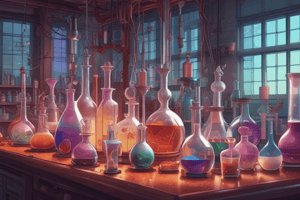Podcast
Questions and Answers
What is the titrant for this experiment?
What is the titrant for this experiment?
NaOH (base)
Where will the titrant originally be found?
Where will the titrant originally be found?
buret
What is the analyte for this titration?
What is the analyte for this titration?
HCl (acid)
Where will the analyte originally be found?
Where will the analyte originally be found?
What is the molar concentration of HCl in the given experiment?
What is the molar concentration of HCl in the given experiment?
What is the primary standard used in this experiment?
What is the primary standard used in this experiment?
What is the secondary standard used in this experiment?
What is the secondary standard used in this experiment?
Is the indicator generally added to the titrant or analyte in a titration?
Is the indicator generally added to the titrant or analyte in a titration?
Distinguish between a stoichiometric point and an endpoint in an acid-base titration.
Distinguish between a stoichiometric point and an endpoint in an acid-base titration.
When rinsing a buret after cleaning, should the rinse be dispersed through the tip or the opening on the top?
When rinsing a buret after cleaning, should the rinse be dispersed through the tip or the opening on the top?
Why is the final rinse of the buret done with the NaOH titrant rather than deionized water?
Why is the final rinse of the buret done with the NaOH titrant rather than deionized water?
Calculate the mass of the KHCHO that reacts with 15 mL of the 15 M NaOH solution.
Calculate the mass of the KHCHO that reacts with 15 mL of the 15 M NaOH solution.
How will you dispense 25.00 mL of the unknown acid into your Erlenmeyer flask?
How will you dispense 25.00 mL of the unknown acid into your Erlenmeyer flask?
What is the correct way to fill your NaOH buret?
What is the correct way to fill your NaOH buret?
Flashcards are hidden until you start studying
Study Notes
Titration Basics
- Titrant for the experiment is Sodium Hydroxide (NaOH), which acts as the base.
- Analyte in the titration is Hydrochloric Acid (HCl).
Equipment and Setup
- Titrant is stored in a buret, which allows precise dispensing.
- The analyte is placed in an Erlenmeyer flask for mixing and titration.
Concentration Calculations
- To find the molarity of HCl, perform the following:
- Calculate moles of NaOH used: moles = molarity (0.9971 M) × volume (0.03615 L) = 0.03606 mol.
- Molar concentration of HCl: (0.03606 mol) / (0.0250 L) = 1.442 M.
Standards
- Primary standard in this experiment is Potassium Hydrogen Phthalate (KHC₈H₄O₄), a substance with an accurate mass used for calibration.
- Sodium Hydroxide becomes a secondary standard after its molar concentration is determined.
Indicators and Endpoints
- Phenolphthalein is the chosen indicator, added to the analyte; it is colorless in acidic solution and turns pink in basic conditions.
- Stoichiometric point signifies complete reaction, while the endpoint is indicated by a change in color due to pH change.
Buret Rinsing Technique
- Rinse buret using water through the tip to ensure it is clean.
- Final rinse should use NaOH to avoid contamination, as residual water could alter measurements.
Mass Calculation
- To calculate mass of Potassium Hydrogen Phthalate reacting with NaOH:
- 15 mL of 15 M NaOH leads to 0.00225 mol NaOH.
- This equals 0.00225 mol KHCHO, resulting in a mass of approximately 0.4595 g when multiplied by the molar mass (204.23 g/mol).
Dispensing Unknown Acid
- 25.00 mL of the unknown HCl acid is measured using an appropriately labeled buret (A, B, or C).
Correct Buret Filling Procedure
- Use a clean beaker to pour about 100 mL of NaOH into a funnel on top of the buret.
- Keep excess NaOH in the beaker for future fill-ups; do not return to the original storage to prevent contamination.
Studying That Suits You
Use AI to generate personalized quizzes and flashcards to suit your learning preferences.




